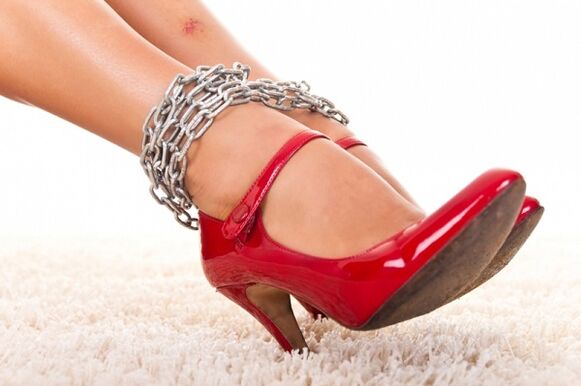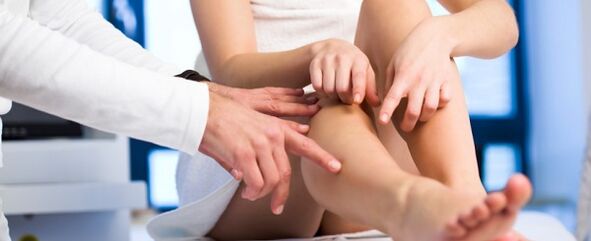Varicose is a pathological condition, a result of chronic venous insufficiency, in which the venous walls become thinner, the lumen of the veins increases and an extension (nodes) aneurysm is formed.Visually, the veins become very swollen, blue in color, coil.It is manifested by a feeling of heaviness in the legs and their fatigue, swelling of the legs and legs, night convulsions in the legs.
The causes of varicose veins
It is impossible to point out a specific cause, but there are a number of factors that can cause an increase in pressure and reduce the elasticity of the veins, as well as the weakening of the valves, resulting in varicose veins.
Clinical phlebology distinguishes a number of provocative factors leading to varicose veins:
- Work on your legs or a long stay in an upright position.
- Using socks with strong elastic bands that squeeze their feet.
- Weakness of the tissues as a result of congenital characteristics.
- Directing.The legs have an increased load of the whole body.This factor is dangerous for people whose work involves a long position.
- Genetic predisposition.If the parents have had varicose veins, then a child with a probability of 70% will also have the development of the pathology.It is true that the risks can be reduced by avoiding their appearance.To do this, you just need to not create provocative factors.With genetic predisposition, varicose veins appear very early.
- Life.If a person is not active enough, then the risk of varicose veins increases.Phlebologists call a similar condition "computer varicose veins".
- Hormonal malfunctions and fetal bearing.During pregnancy, varicose veins develop due to an increase in blood volume, as well as compression of the veins that increase in the size of the uterus.In hormonal damage, the production of progesterone and the decrease in the increase in estrogen synthesis, which increases blood coagulation.
- Obstacles from blood flow.This condition occurs in the formation of blood clots, the development of tumors.
- Obesity.Excess weight increases the load on the legs, begins malnutrition of the bloodstream, and excess weight causes an increase in abdominal pressure, which changes blood flow.
- Diabetes.In the case of illness, the high rate of sugar begins to damage the vascular system, leading to the formation of blood clots.
- Stress and nervous disorders affect the blood vessels, leading to the development of varicose veins.
- Alcohol abuse.Alcohol is capable of bending the body and with excessive consumption the blood thickens, clogging of the veins and malnutrition of the blood flow begins.
- Unstable nutrition.If the body does not receive vitamins C, E, P, as well as beneficial trace elements: the circulation is impaired, the condition of the blood vessels worsens, leading to varicose veins.
- Frequently delaying stools.In this case, the abdominal pressure increases and blood flow to the legs is impaired.
- Pathologies of the kidneys and heart.
- An overrich of drugs to increase blood coagulation.

Depending on the cause of the disease, 3 main stages of varicose veins can be distinguished:
- Compensation.
- Subcompensation.
- Decompensation.
Varicose veins are not applied to serious pathologies, but terrible with its complications.
Pay attention!If the disease occurs, then it will not go away on its own.The untimely appeal of a specialist leads to serious disorders that pose a danger.
The main symptoms of varicose veins
The clinical picture of varicose veins is not difficult, this allows the phlebologist to quickly make a preliminary diagnosis and direct the patient to an instrumental diagnosis.

Among the main signs of varicose enlargement, they distinguish:
- The appearance of swelling on the legs until the end of the day, in the evening.The first symptom is possible, especially when you wear tight shoes.After a normal rest in the morning, the swelling disappears.
- Weight in the legs.One experiences not only weight but also calves, especially after a working day.A symptom is more common in people with sedentary work.If you spend a walk in the evening and provide a good break, the signs disappear in the morning, but in the evening they appear again.
- Strong heat in the legs, namely with calves.
- Night convulsions that reduce caviar.
- The appearance of a vascular network of the legs (blue-red "stars").
- Increasing the veins on the legs (as if it is in a hurry over the skin).This function develops one of the latter and speaks of pronounced varicose enlargement.
The symptoms described are subject to compulsory treatment than before to do, the less serious complications will be.
Complications of varicose veins
With the advent of varicose veins, the pathology itself will not pass and without treatment begins to give complications.What are the dangerous varicose veins and what consequences can be against the background of the disease?
The complex form of varicose veins is declared by:
- Thrombophlebitis in acute form.
- Trophic ulcers.
- Phlebotrombosis.
- Bleeding.
The progressive disease causes the development of varicotrombophlebitis and then phlebotrombosis.Such conditions affect the deep veins, the blood flow to the legs is not only disturbed, but can stop, which is why gangrene is formed.
Diagnosis of varicose veins
At the beginning of the development of varicose veins, symptoms are not usually expressed, often pain in the legs and other sensations are written off when fatigue.
The patient is not determined when a doctor's visit to the doctor (when the veins start to swell and this becomes a noticeable naked eye).
Diagnosis of varicose veins deals with a specialist-fotobologist, the diagnosis is established on the basis of a conversation with the patient, confrontation, and diagnostic data, in particular :::
- Color duplex examination.It allows for measuring the speed, the direction of the blood.The data allows you to draw up a blood flow card.
- Phlebography.Show the external characteristics of the veins, the operation of the valves.The method is used in extreme cases.
- Diagnostic Samples - Allow you to determine the patency of the veins and the condition of the valves.The most common collapse is Troyanov.
- Doppler - a blood flow is performed in a particular vessel.
The methods described are used to diagnose surface and deep veins.
The consequences of varicose veins on the legs
The danger is not in the varicose veins themselves, but the subsequent complications and consequences that become a real threat to human life.Think more detailed.
Venous deficit
This condition involves several steps of development.At the very beginning of venous insufficiency, the changes are insignificant and a horizontal venous reflux appears.

4 stages can be distinguished:
- ZeroSThere are no characteristic symptoms, only temporary swelling of the legs occurs, the veins are slightly noticeable.
- FirstSIt is accompanied by a severe expansion of the enlarged vessels in the legs, but there are no trophic damage.
- SecondSThe obvious appearance of veins on the legs with a large number of nodes, the legs are affected by eczema, ulcers.
- ThirdSA steady trophic disorder that cannot be stopped with medication.
In chronic venous insufficiency, patients appear with the following symptoms:
- Itching.
- Pain.
- Convulsions.
- Swelling.
- Blood stagnation and the appearance of formations (enlarged nodes).
- Ulcers.
Thrombophlebitis
This complication is characterized by the appearance of blood clots that clog the vessels.The blood becomes viscous, leading to a complication of the outflow.The upper part of the lower legs and lower thigh is affected.The phlebologist can easily determine the complication of the pronounced changes:
- Redness.
- Pain.
- Weakness.
- Tissue seal.
With the development of thrombophlebitis, many veins, including the pulmonary artery, have been affected.Treatment for thrombophlebitis should be performed without delay in the first symptoms, the surgery is used as therapy.
Outpatient therapy is performed at the initial stages if the varicose veins have not reached the lower leg.
For treatment they use:
- Non -steroidal drugs to eliminate inflammation.
- Anticoagulants.
- Angioprotectors.
- Diggarts.
Trophile ulcer
Trophic ulcer is always found in advanced cases where blood flow is very disturbed.Characteristic signs of complication:
- Slow formation.
- The darkening of the skin on the feet, strong pigmentation.
Any leg injury can cause damage and rupture of ulcers.If you provide an ambulance, then there will be no consequences and the injury will quickly heal, otherwise the inflammation of the tissues begins, the development of a bacterial infection of varying severity is possible.
Surgery is performed for the treatment of complex trophic ulcers.During treatment, experts prescribe bed rest for 2 or more weeks.Wide -acting antibiotics, regenerating drugs and topical antiseptics are prescribed as conservative treatment.
Pulmonary artery thromboembolism
Thromboembolism is the most dangerous and often deadly consequence.This condition involves occlusion of the pulmonary artery or its thrombotic branches from the masses that have come out.
The main risks of development:
- Oncology.
- Performing surgery.
- Heart failure.
- Thrombophilia.
- A long lie.
Women are more often the subject of complications, development is possible even in children.You can determine the pulmonary artery thromboembolium with the following symptoms:
- Thoracic pain.
- Temperature growth.
- Tachycardia.
- Expectation with blood.
- Cough.
- Wheezing.
- Dyspnea.
It is impossible to diagnose the disease itself, with suspected thromboembolism, is performed urgent hospitalization.
Treatment of varicose veins and prevention
To date, several basic types of varicose enlargement treatment are used:
- Conservative treatment.The technique depends on the stage of the disease.Use drug therapy, sclerotherapy for the affected veins, treatment of compression.
- Surgical treatment.Several types of operations are included in this method: radio frequencies of the veins, endovan thermal occlusion, exploitation of Varadi, as well as laser coagulation of the veins.
The essence of prevention is to maintain vessels in health, as well as to prevent damage to the venous circulation.
Preventive measures for healthy people are also shown, which, due to genetics or constant work, are possible for the development of varicose veins, as well as for those already suffering from varicose veins.
For prevention purposes you need: Must:
- In order to control body weight, with obesity to the legs, the high load is, blood circulation and blood vessels cannot work normally.By applying mass reduction diets, the menu must be controlled so that it is correct and complete.
- It is right to eat so that there are products in the diet that strengthen the vascular system and normalize blood circulation.More plant foods need to be included, bread made from coarse flour.
- Perform moderate physical activity that prevent varicose veins and keep the veins of the legs in good shape.Swimming, walking, dancing is perfect.
- Wear free clothes, shoes.
- Use products in the form of ointments and creams that can saturate tissues with nutrients, improve blood circulation, strengthen blood vessels.
Even if varicose veins begin to develop, prevention can significantly slow down the development of pathology, reduce the risk of complications.























